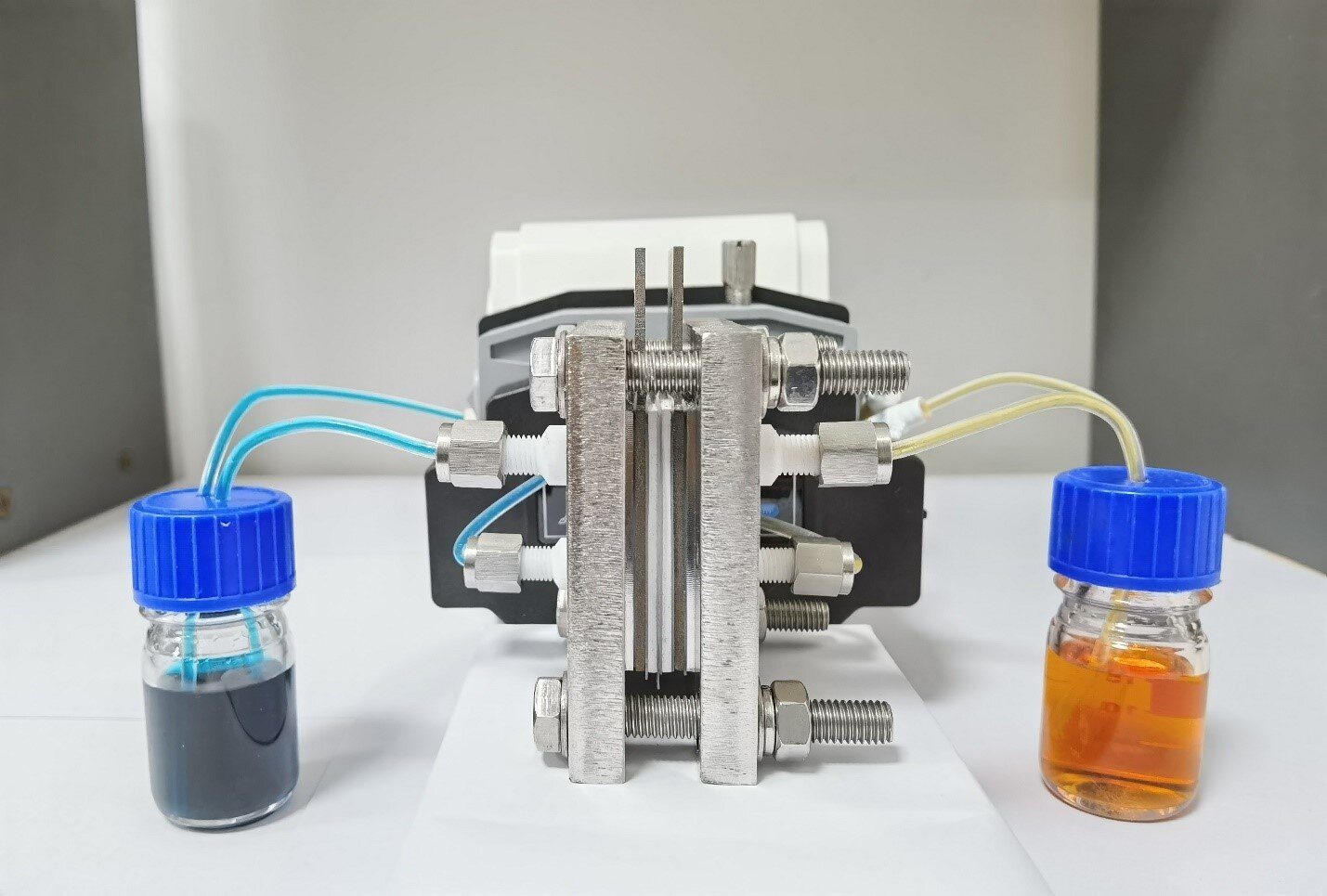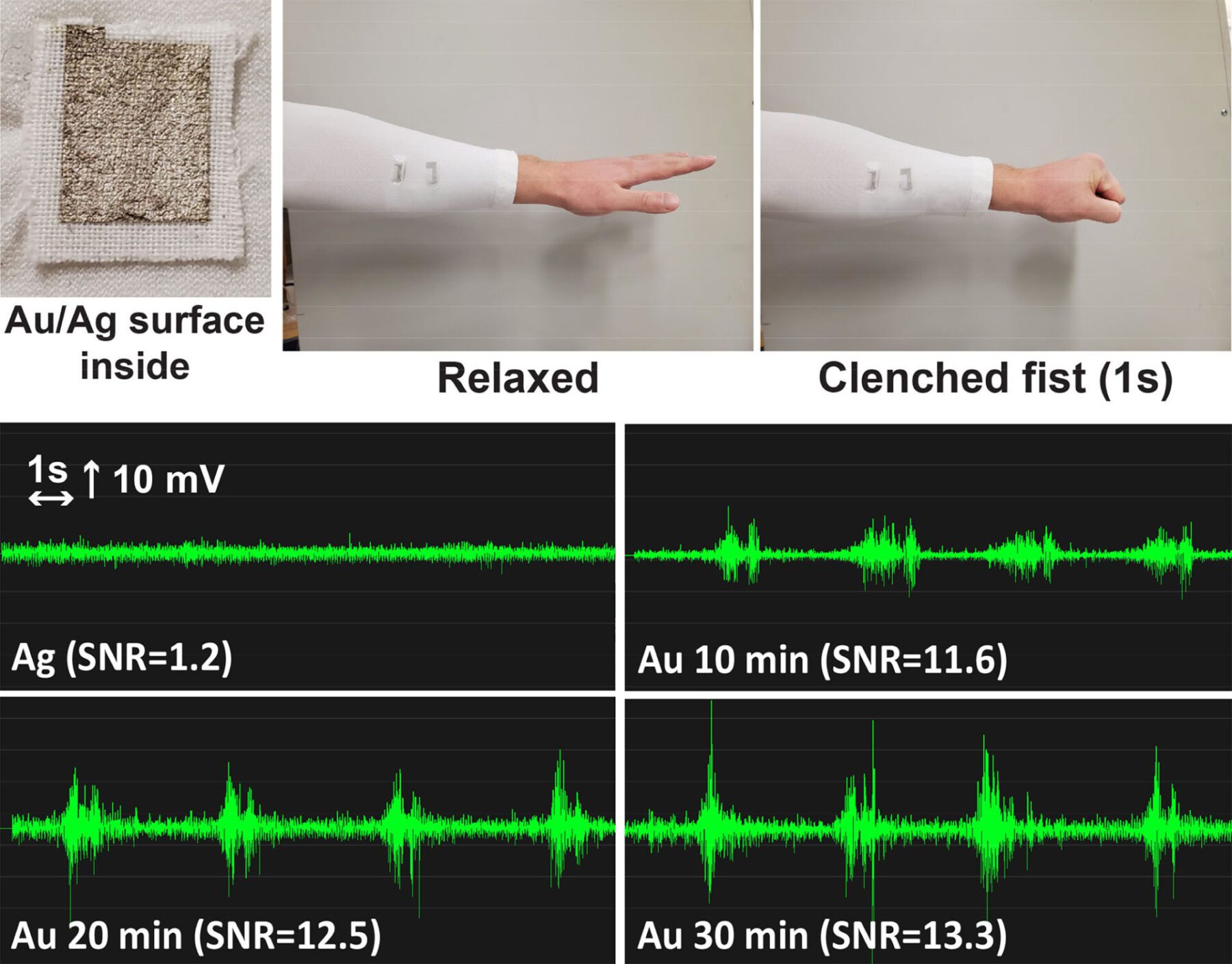
Photo of aqueous redox flow battery
CREDIT: Liwen Wang, South China University of Technology
To produce a cost-effective redox flow battery, researchers based at the South China University of Technology have synthesized a molecular compound that serves as a low-cost electrolyte, enabling a stable flow battery that retains 99.98% capacity per cycle. They published their approach on August 14 in the Energy Material Advances.
Comprising two tanks of opposing liquid electrolytes, the battery pumps the positive and negative liquids along a membrane separator sandwiched between electrodes, facilitating ion exchanges to produce energy. Significant work has been dedicated to developing the negative electrolyte liquid, while the positive electrolyte liquid has received less attention, according to corresponding author Zhenxing Liang, professor in the Key Laboratory of Fuel Cell Technology of Guangdong Province, School of Chemistry and Chemical Engineering, South China University of Technology.
“Aqueous redox flow batteries can realize the stable electrical output for using unsteady solar and wind energy, and they have been recognized as a promising large-scale energy storage technology,” Liang said. “Electroactive organic merit of element abundance, low cost and flexible molecular control over the electrochemical features for both positive and negative electrolytes are regarded as key to developing next-generation redox flow batteries.”
Liang and his team focused on TEMPO, a chemical compound with easily reversed oxidation states and high potential for energy, a desired quality in positive electrolytes.
“However, TEMPO cannot be directly applied to aqueous redox flow batteries due to the high hydrophobicity of the molecular skeleton,” Liang said, explaining that TEMPO, left unmodified, will not dissolve in the liquid needed to facilitate the energy exchange in the flow batteries. “We developed a strategy to functionalize TEMPO with viologen, an organic compound that has highly reversible redox reactions, to improve TEMPO’s hydrophilicity.”
According to Liang, viologen is highly soluble in water, which increases TEMPO’s ability to dissolve in water. Viologen also chemically withdraws electrons from atomic partners, which elevates its potential to change its oxidative state. Viologen is also a salt, which endows TEMPO with what Liang calls “a decent conductivity” in an aqueous solution.
When the synthesized viologen-modified TEMPO was tested in a flow battery, the researchers found that the battery retained capacity of 99.98% per cycle, meaning the battery could hold nearly all its stored energy when not in active use.
“This work overcomes the disadvantages of TEMPO by viologen-functionalization and realizes its application in aqueous redox flow battery,” Liang said. “The molecular design concept provides a strategy for novel organic electroactive materials and lays a foundation for the application of aqueous organic flow battery.”
Original Article: Newly developed compound may enable sustainable, cost-effective, large-scale energy storage
More from: Southern University of Science and Technology
The Latest Updates from Bing News & Google News
Go deeper with Bing News on:
Redox flow battery
- BHP makes $60 billion bid for Anglo American
Shares in BHP (ASX:BHP) will come under pressure on the ASX on Friday after it confirmed it had made an unsolicited all-paper takeover offer for Anglo American, with a value of around $60 billion.
- US economic growth disappoints
In the wake of the weaker-than-expected first estimate of US economic growth, it seems US interest rates aren’t going lower for a while longer—perhaps past November’s elections—unless there is a ...
- Disrupting Energy Storage
There’s a great deal of research taking place with battery technologies to find a viable alternative to lithium-ion (Li-ion) batteries, which will find its way to the power ...
- Bhisho welcomes new investors to EL SEZ
The Eastern Cape government has welcomed investments in the East London Special Economic Zone totalling R1.3 billion.
- IDTechEx Discusses Future Market Penetration of the Redox Flow Battery
The evolution of the redox flow battery over several decades has seen various chemistries being developed, commercialized, or even abandoned due to factors such as poor electrochemical reversibility ...
Go deeper with Google Headlines on:
Redox flow battery
[google_news title=”” keyword=”redox flow battery” num_posts=”5″ blurb_length=”0″ show_thumb=”left”]
Go deeper with Bing News on:
Large-scale energy storage
- ESB: Irish electricity network reaches 1GW of available energy storage
ESB Networks has announced that Ireland’s electricity grid now has 1GW of energy storage available from different BESS assets.
- Massive energy storage deal for Trina, Pacific Green
Trina Storage and Pacific Green have signed a major agreement of energy storage solutions across multiple jurisdictions.
- Using liquid metal to develop energy storage systems with 100 times better heat transfer
The industrial production of steel, concrete, or glass requires more than 20% of Germany's total energy consumption. Up to now, 90% of the fuels used for these processes have been of fossil nature.
- Going with the flow: Research dives into electrodes on energy storage batteries
As a grid-scale energy storage system, flow batteries have gained increasing attention as a means to address the challenges associated with fluctuations and intermittency in renewable energy sources.
- Shutesbury TM on Saturday will rule on battery storage, lighting bylaws, citizen petitions and hold elections
SHUTESBURY — Bylaws to regulate large-scale battery storage, limit outdoor light pollution, reduce greenhouse gas emissions in new housing construction and control door-to-door solicitors will be ...
Go deeper with Google Headlines on:
Large-scale energy storage
[google_news title=”” keyword=”large-scale energy storage” num_posts=”5″ blurb_length=”0″ show_thumb=”left”]










